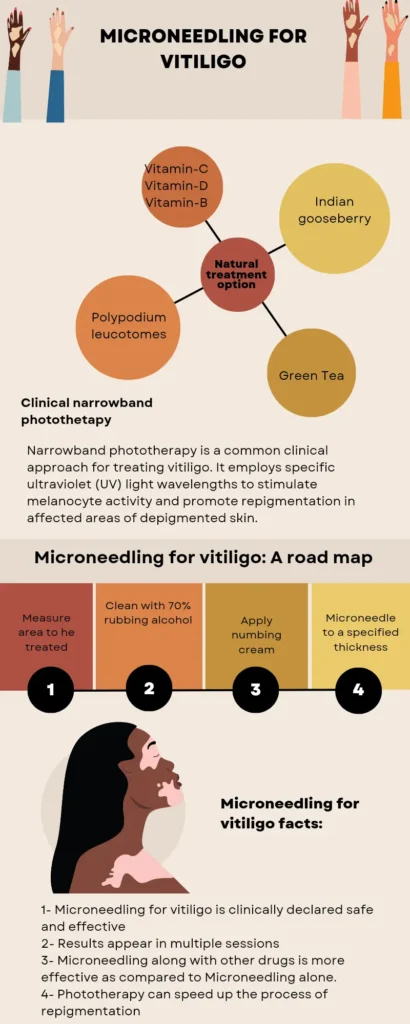Vitiligo treatment with microneedling: regrets
Updated: 10 December 2023
81

Let’s dive into depth to find answer of a very common question, ” Is microneedling safe for vitiligo”?. Vitiligo is a skin condition that doesn’t cause physical discomfort, but it leads to the gradual loss of skin pigment due to damage to melanocytes, which can sometimes be linked to other immune-related issues. This condition can have a significant impact on a person’s mental well-being, especially if they have dark skin, and it’s often unpredictable.
Is microneedling safe for vitiligo?: 4 effective alternatives
While we’re still not entirely sure what causes vitiligo, various factors like genetics, autoimmune processes, psychological factors, and environmental influences are thought to be involved. Despite many available treatments, finding an effective solution for this condition remains challenging.
Micro needling for vitiligo is one potential approach, which involves tiny needles creating micro-injuries in the skin’s upper layer. This process not only helps with the delivery of medications through the skin but also triggers the release of growth factors that could encourage melanocyte migration and aid in repigmentation.
The science behind microneedling for vitiligo
Using microneedling to stimulate the skin’s healing response in vitiligo can help the body produce substances like transforming growth factor (TGF-), platelet-derived growth factor (PDGF), and other helpful factors. These substances encourage the return of skin pigment. Microneedling also creates tiny injuries in the skin’s lower layer, leading to an increase in certain skin cells that aid in repigmentation.
Furthermore, during microneedling for vitiligo, melanocytes (the cells responsible for skin color) from the needle tips can prompt their movement from areas around the vitiligo patch or any pigment near hair follicles to the areas lacking pigment. All of these factors work together to activate melanin production, which is essential for repigmentation in vitiligo.
Phototherapy treatment options for vitiligo
Sunlight, specifically through phototherapy, plays a vital role in vitiligo treatment. Controlled exposure to natural sunlight or specialized UVB/UVA phototherapy can stimulate melanocytes and aid in repigmentation. Patients should follow their dermatologist’s guidance for safe sun exposure and treatment consistency for optimal results.
Sunlight exposure therapies for vitiligo include:
1. Natural Sunlight Exposure
Controlled exposure to natural sunlight.
2.Narrowband UVB (NB-UVB) Phototherapy
Using a specific narrowband of UVB light for treatment
3. PUVA (Psoralen plus UVA) Therapy:
Combining psoralen medication with UVA exposure for treatment.
4. Home Phototherapy
Use of controlled UVB or UVA devices at home under professional guidance.
Combination treatment options while microneedling for vitiligo
- Microneedling alone is effective, microneedling pigment therapy show amazing results
- Microneedling along with topical tacrolimus, repigmentation rate is 75% with this combination as compared to monotherapy.
- Microneedling + topical calcipotriol + betamethasone
- Microneedling in combination with latanoprost
- Microneedling with 5-Flurouracil
- Microneedling with triamcinolone acetonid
- Narrow-band phototherapy

Number of microneedling sessions for vitiligo patient
Micro needling for vitiligo never be used as primary treatment option. Infact, it is used in combination with other treatment options. The process requires alot of patience and the patients need to visit the clinic fortnightly to maintain cells turn-over. Microneedling for vitiligo cannot be done at home because the process it complicated, it involves needling across the sides of vitiligo patch to increase cells stimulation.
In summary, microneedling for vitiligo emerges as a promising supplementary approach in the treatment. It should be noted that it is not a standalone solution but can complement other therapies to potentially augment repigmentation. Microneedling’s mechanism involves triggering the skin’s innate healing response, facilitating the release of growth factors, and supporting melanocyte migration, all contributing to the process of repigmentation.
However, its effectiveness can vary from person to person, and it should only be administered under the guidance of a dermatologist or healthcare professional as part of a comprehensive vitiligo treatment strategy. Further research and clinical investigations are needed to gain a deeper understanding of its long-term efficacy and safety.
| Disclaimer |
|---|
We do not provide any online consultation regarding microneedling for special conditions i.e., vitiligo. The patient needs to be assessed at the clinic and the treatment regimen will be decided afterwards. Microneedling for vitiligo at home is strictly not advisable |
Please Write Your Comments